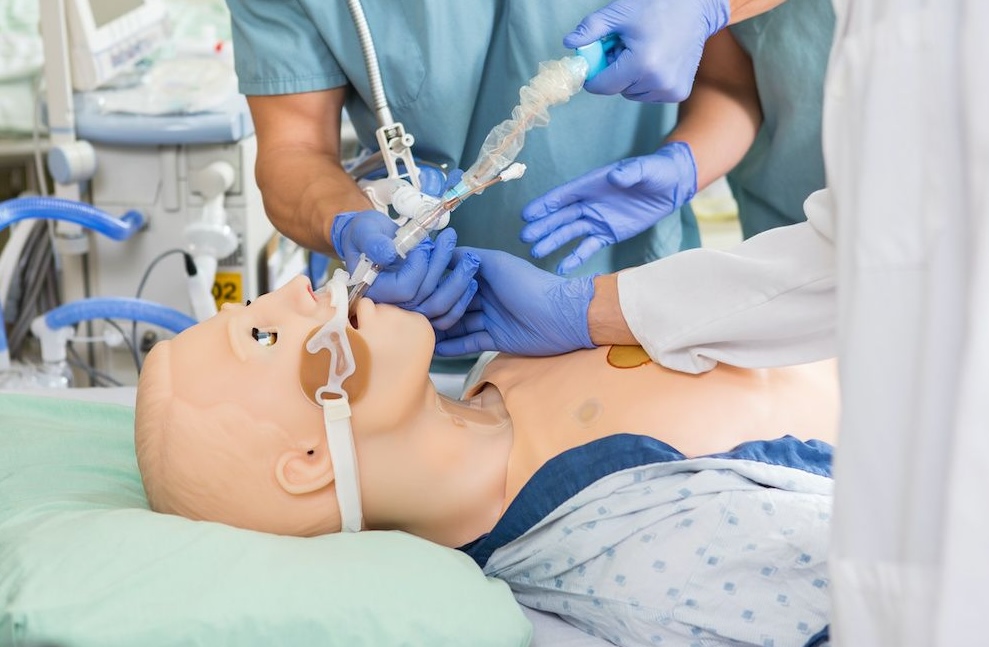In a post-pandemic world of high school education, Allied Health Occupations teachers grapple with junior- and senior-level student engagement in healthcare simulation-based learning and application of practical clinical skills. Regardless of the challenges depicted by remote learning during a pandemic, there are educational opportunities to integrate medical simulation for virtual, hybrid, and in-person clinical skills development for students within Allied Health Occupations classes. This article, written by Barbara Olander, BSN, RN, aims to identify perceived and realistic challenges of remote learning for Allied Health Occupations teachers and high school students to embrace learning opportunities in varied simulation-based educational settings.
Barriers to Digital Skills Teaching and Student Learning
The use of technology in high school education became a necessity in March 2020 when Covid-19 was declared a global pandemic. This sudden and unexpected shift in teaching methods presented novel challenges for high-school Allied Health Occupations teachers and students. Teachers were required to adjust practical skills teaching and student acquisition for immediate online delivery.
Post Covid-19 research identified barriers presented by digital technologies in health science education generally and in practical skill acquisition specifically. Barriers include:
- Socioeconomic Barriers: increased student stress and concerns of falling behind in required coursework and financial burden from the cost of technology devices, such as webcams and computers, and high cost of internet access, especially to disadvantaged students.
- Environmental Barriers: lack of internet access, poor internet access, and slow internet speed.
- Digital Literacy Among Teachers: unfamiliarity and lack of experience with digitally supported teaching methods hindered student engagement and learning.
- Technological Challenges: remote labs required increased data and high-speed internet connections; unavailable web links and e-learning platforms failed to deliver quality resources and learning experiences.
- Lack of Teacher-Student Interaction: student feelings of isolation and fear of asking questions and clarifying information with the teacher, and reduced or absent opportunities for real-time feedback during required clinical skills practice.
- Negative Attitudes Towards Online Learning: teachers experienced increased workloads due to time-consuming preparation and recording of digital learning materials; student perceptions identified as inadequate; and inappropriate learning of hands-on skills through digital teaching and felt that teachers were not doing their job.
- Skill Suitability: teachers noted a lack of formal simulation-based digital learning objectives in the curriculum, which led to the development of inadequate simulation-based education activities; students did not experience relevant simulation-based education and considered it an inadequate substitute for in-person clinical skills learning; and student experiences lacked physical hands-on touch when learning skills through online skills demonstration videos.
View the HealthySimulation.com LEARN CE/CME Platform Webinar Nursing 101 Skills Training Kit from Remedy Simulation Group to learn more!
Digital Skills Teaching and Student Learning: Suggestions for Improvement
Evidence-based research suggests overcoming challenges, leveraging opportunities, and promoting successful integration of digital learning in allied health occupations education. Simulation-based education that incorporates digital learning must involve collaborative and effective engagement between students and teachers. Suggestions for removing barriers to remote digital learning:
Socioeconomic Barriers: Provide students with laptops and webcams or Chromebooks for home use; schedule hands-on skills practice time for students to utilize on-campus manikins and required equipment; request and advocate a budget increase for digital imaging software to ensure increased remote usage; Provide digital learning material in written, aural, or visual formats to address student diversity in simulation- based learning.
Environmental Barriers: Allow supervised access to computer labs and the library on evenings and weekends; Identify minimum standards required for optimal sound and video quality; Instruct students to perform audio checks before streaming online material, especially when practical skills learning is required.
Digital Literacy Among Teachers: Explore the use of open educational resources (OERs); Address the relevancy of the need to share online digital simulation educational materials; Use creative commons licensing to learn from and use appropriate parts of resources created by others to maximize the impact of high-quality digital simulation teaching and avoid duplication of work; Share personal ideas and relevant information learned from TeamSTEPPS, which is an evidence-based framework to optimize team performance across the health care delivery system.
Technological Challenges: Ensure adequate IT support for teachers and students to handle unexpected issues, such as connectivity issues during required simulation-based learning activities; Encourage the use of mobile hotspots; Provide troubleshooting guides for both teachers and students to promote positive engagement with the use of new and required technology.
Lack of Teacher-Student Interaction: Minimize students’ feelings of isolation by use of a digitized ‘thumbs up’ to confirm student engagement and understanding of learning; Allow students to ask questions anonymously during live online classes; Provide interactive digital simulation learning activities that involve simultaneous teacher/student communication and opportunities for immediate teacher feedback.
Negative Attitudes Towards Online Learning: Explore teacher and student attitudes and experiences with remote digital learning; Allow students self-paced learning activities with video recordings for student self-review and opportunity to improve learning; Provide realistic learning opportunities with the use of virtual diverse patient simulation for active student engagement.
Skill Suitability: Collaborate with software designers and developers to communicate teachers’ instructional needs and curriculum-based learning needs for high school Allied Health Occupations students; Identify simulation-based clinical skills that are user-friendly and appropriate for remote digital learning; Provide high-quality skills learning opportunities for repetitive practice to support student learning; Acknowledge student learner differences and adjust learning opportunities for students that struggle with independent learning; Provide additional teacher guidance and feedback to struggling students.
Opportunity for Teaching High Schools Students with Simulation is Clear
Allied Health Occupations teachers and high school students have identified challenges to meaningful and efficient use of digital simulation-based practical skills learning. Despite these challenges, teachers and students recognize the need for sharing meaningful and efficient digital learning experiences. In conclusion, remote digital learning barriers noted before, during, and after Covid-19 provide ongoing opportunities for research studies, simulation-based software development, and implementation of high-quality digital simulation-based education at the teacher, student, IT, institution, and digital software levels.
Learn More About Healthcare Simulation for High Schoolers!
References:
- Forde C, OBrien A. A Literature Review of Barriers and Opportunities Presented by Digitally Enhanced Practical Skill Teaching and Learning in Health Science Education. MEDICAL EDUCATION ONLINE 2022, VOL. 27, 2068210 https://doi.org/10.1080/10872981.2022.2068210
- Astbury J, Ferguson J, Silverthorne J, Willis S, Schafheutle E. High-fidelity simulation-based education in pre-registration healthcare programmes: a systematic review of reviews to inform collaborative and interprofessional best practice. JOURNAL OF INTERPROFESSIONAL CARE 2021, VOL. 35, NO. 4, 622–632 https://doi.org/10.1080/13561820.2020.1762551









